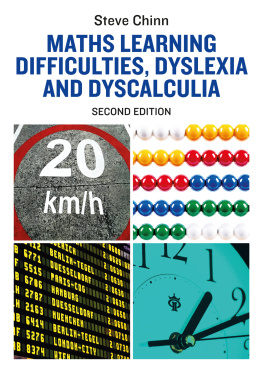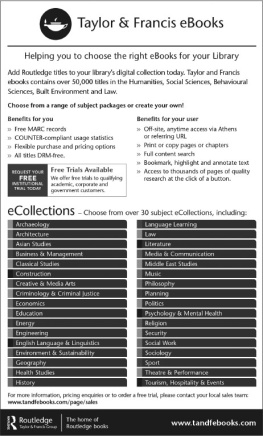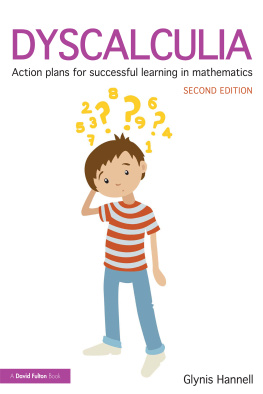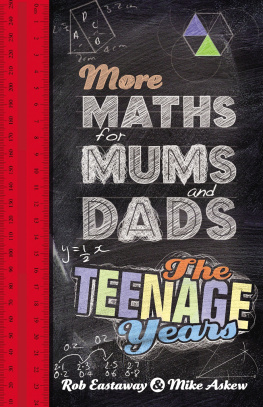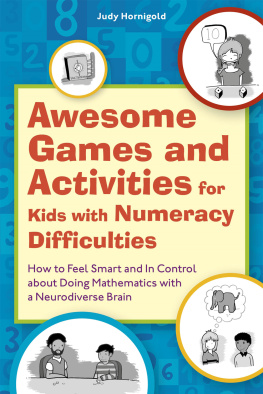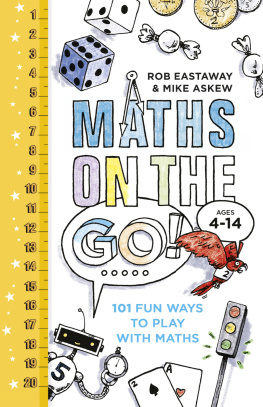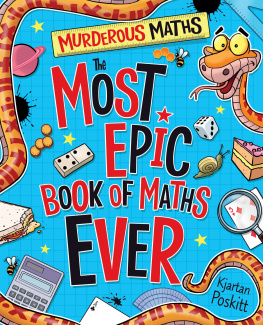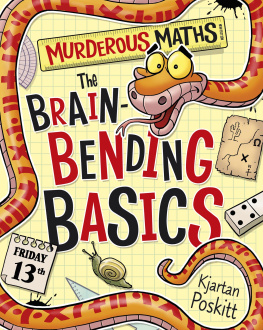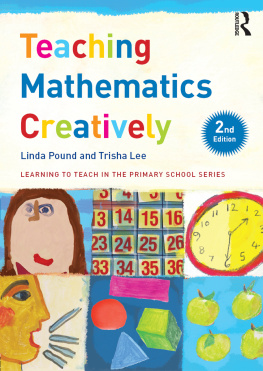
Maths Learning
Difficulties, Dyslexia
and Dyscalculia
Second Edition
Steve Chinn

Jessica Kingsley Publishers
London and Philadelphia
Contents
Introduction
After 14 years of teaching in mainstream schools, in 1981 I took up a post which would make me the first Head of a new specialist secondary school for dyslexic boys. As a science teacher I was given the job of teaching mathematics to twelve very dyslexic students. I had been a very successful teacher in mainstream, but I was about to find out that I did not have the skills to teach my new students effectively.
In that brief biographical paragraph is the raison dtre for the next 30 years or so of my professional life and one persons realisation that specialist teacher training is essential if children who experience specific learning difficulties in maths are to be educated to the same standards of achievement as their peers.
Back in the 1980s very little was known about dyslexias impact on learning maths and certainly we did not use the word dyscalculia.
In 2019 mathematics learning difficulties and dyscalculia remain behind dyslexia in terms of research and understanding, but current knowledge is getting stronger and more research is being published. The rise of neuropsychology and brain scans is pushing our knowledge forward. However, this book is rooted in the classroom and thus about the pragmatics of teaching and learning.
One of my dreams is to see similar levels of acceptance and understanding in education for dyscalculia and maths learning difficulties (LD). The second goal is the training of a body of assessors, specialist teachers and learning support assistants. The third goal is that there will be a much greater recognition and acceptance of an adjusted pedagogy for maths learning difficulties led by our Government.
This short book can only give an overview of the many issues that are involved in mathematics learning difficulties and dyscalculia, but it is an overview that should highlight problems and point towards understanding and interventions. There are some themes that run through the book, for example, using key facts in a developmental way. The themes acknowledge the need to constantly revisit topics and extend them, building on secure foundations.
A pragmatic mantra: take the intervention back to the beginning and then proceed at a pace and with a style to match the needs of the student.
At the end of the book there is a list of References and Further Reading, some written by me, for those who wish to follow up any particular aspects or topics in more detail. My video tutorials, Maths Explained, show in detail how I teach maths.
Chapter 1
Dyslexia, Dyscalculia and
Maths Learning Difficulties
As our knowledge of the theoretical bases of learning difficulties has improved so has awareness in schools. It would be beneficial to include that knowledge in all teacher training, coupled with pragmatic intervention methods, so that it is available at that critical interface between learner and teacher. There is a long way to go, but we have started.
The concept of comorbidity or co-occurrence of learning difficulties and their influences is now recognised. I was unaware in 1981 that my students, who were identified as dyslexic, could also have very significant difficulties with maths. This was not a unique situation at that time. We in the UK teaching profession were unaware of Asperger syndrome. We didnt understand attention deficit hyperactivity disorder (ADHD) or dyspraxia. Although Kosc had written about dyscalculia in 1974 only a few teachers were aware of its existence, but they were certainly well aware of underachievement in maths. Not many years ago people argued, often quite vehemently, as to whether dyslexia was dyslexia or specific learning difficulty or even specific learning difficulties/dyslexia and thats before we get to the discussions on difficulty and disability. These arguments did not include anything about the influence of dyslexia and other learning difficulties on learning maths.
There was a long definition of learning disabilities, the then alternative term used for dyslexia in the USA (Kavanagh and Truss 1988, p.550). As you read it, note how comprehensive it is regarding the influences, factors and co-occurring issues involved in LD:
Learning disabilities is a generic term that refers to a heterogeneous group of disorders manifested by significant difficulties in the acquisition of listening, speaking, reading, writing, reasoning or mathematical abilities or of social skills. These disorders are intrinsic to the individual and presumed to be due to central nervous system dysfunction. Even though a learning disability may occur concomitantly with other handicapping conditions (e.g., sensory impairment, mental retardation, social and emotional disturbance), with socio-environmental influences (e.g., cultural differences, insufficient or inappropriate instruction, psychogenic factors) and especially with attention deficit disorder, all of which may cause learning problems, a learning disability is not the direct result of those conditions or influences.
Let me pick out the word heterogeneous. Recent research on dyscalculia has described it as a heterogeneous condition, that is, there is not one single profile. We have to look at a range of potentially contributing factors (see ).
The pioneering work of Sharma in the USA on maths difficulties was not known at that time in the UK, nor his journals, Focus on Learning Problems in Mathematics and Math Notebook . He remains a leading pragmatist in the field.
After an initial flurry of interest from the Department of Education in the UK around the millennium, interest in dyscalculia seems to have waned somewhat. The definition below is the one that the Department for Education and Skills published back in 2001. It has not been refreshed.
Dyscalculia is a condition that affects the ability to acquire mathematical skills. Dyscalculic learners may have difficulty understanding simple number concepts, lack an intuitive grasp of numbers and have problems learning number facts and procedures. Even if they produce a correct answer, or use a correct method, they may do so mechanically and without confidence. (DfES 2001, p.2)
Even though this definition is somewhat succinct, it is informative. My understandings of the various features covered in the definition are as follows:
It states that these learners have problems with numbers and thus the quantities represented by the (many) symbols used in maths. This infers problems at the very early stages of maths and thus, for children, the first maths experiences they meet. The use of the word intuitive suggests an inborn ability to deal with numbers/quantities. This should not preclude successful intervention for learners who need to develop that facility later in childhood. We need to remember that there is often a big difference between what children can repeat or chant and what they understand and thus be very wary of an over-dependence on rote learning.
Learning number facts and procedures could suggest that a key approach to maths involves memorising facts and procedures. There is evidence to support this interpretation (for example, Ofsted 2008). Again, an over-reliance on memory, learning by heart, is ineffective for any learner, but is very detrimental for many more than officialdom might acknowledge, particularly those with learning difficulties. There is further evidence that maths education in the UK is seriously ineffective for around 25 per cent of learners (Rashid and Brookes 2010; Chinn 2013). This leads into the part about performing maths tasks mechanically and without confidence and probably infers that the learner lacks an ability to appraise answers for validity and correctness. The skill of estimation () is not a natural one for many learners. This vital life-skill area of maths has, therefore to be taught, and in an empathetic way that matches the learners cognitive (thinking) style.
Next page
